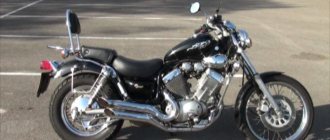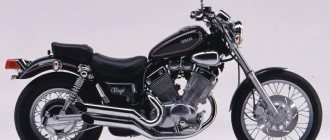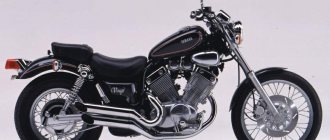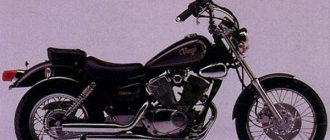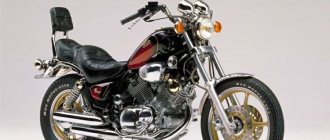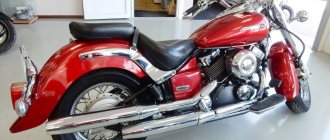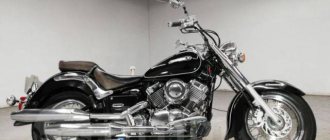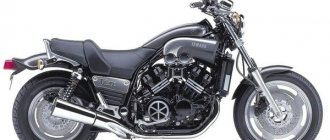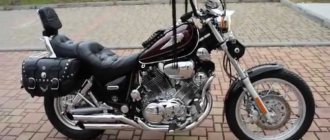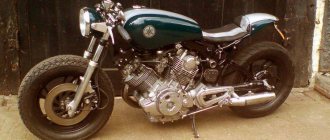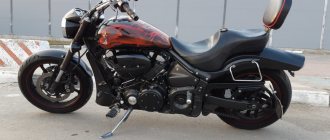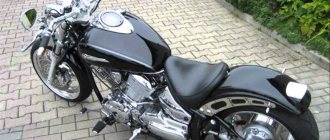Appearance
The bike looks modern. Despite the fact that it is, of course, a cruiser, the car does not look like something from the past. At least if we are talking about the Yamaha XV 125 Virago, painted in black and white. The motorcycle looks modern and stylish, even despite the spoked wheels.
The mirrors are raised high and are large in themselves. This would be strange on any other bike, but on a cruiser it looks normal. As does the large round headlight at the front. As for the frame, its shape is typical for the cruiser class. From the photo you can immediately see that this bike can be used by two people.
Comfort
The motorcycle is comfortable for leisurely trips. The drum brake and large dimensions make high speeds dangerous. The seating is comfortable for both driver and passenger. Although if you want to buy a bike specifically for riding together, you should look for a more suitable model.
If you want to enjoy this motorcycle, it is better to ride at low speeds. Then you will get the feeling that this is a ship smoothly cutting through space. This is why many people love cruisers. They're something of a whale of a motorcycle world, prized for their leisurely majesty rather than their speed.
Dimensions and weight
This is a medium-sized cruiser, even rather small. This is understandable, given that this is a small-capacity bike. However, even despite the weak technical characteristics, this is a cruiser, and therefore it cannot be less than certain standards accepted in the class. Otherwise, it would be almost indistinguishable from many road motorcycles.
The dimensions of the Yamaha XV 125 Virago are as follows:
- height – 1130 mm;
- width – 800 mm;
- length – 2140 mm;
- wheelbase – 1495 mm;
- seat height – 685 mm;
- ground clearance – 140 mm;
- curb weight – 139 kg;
- Tank capacity – 9.5 l.
The tank capacity will not last long. You will have to be content with those routes where there are enough gas stations. Neither this nor any other bike should carry gasoline in cans. Otherwise, there is a high risk that the motorcycle will fall on this canister and a fire will occur.
Technical features of Virago 400
How is the 400cc Yamaha Virago motorcycle different from other choppers? Air-cooled V-twins have one common problem - the rear cylinder often overheats. But, examining numerous reviews on the Yamaha Virago 400, there is no mention of overheating. Thanks to the large camber and the displacement of the second cylinder to the side, air circulates freely between the heads and effectively cools the engine. The power unit is stable even in extreme situations. Even bad gasoline can’t stop you from moving forward.
The cardan transmission , which replaced the chain a year after the start of production, only simplified operation. The reliability of the cardan became the calling card of the “Witch,” destroying many stereotypes. The annual replacement of fluids in the gearbox is all care and maintenance.
Specifications
The Yamaha XV 125 Virago will not impress anyone with its parameters. An experienced biker will only need to watch a test drive video of this model once to understand its mediocrity. And it's not about engine performance. Considering its cubic capacity, one cannot expect more. The main problem of the model is the drum brake.
Yes, perhaps it is sufficient in many situations, but the weight distribution of a car of this class and overall dimensions still require disc brakes both front and rear.
| Motor type | V-shaped, 2 cylinders, 4 strokes |
| Power | 11.4 hp |
| Torque | 9.4 Nm |
| Maximum speed | 107 km/h |
| Acceleration to 100 | 12 s |
| Fuel consumption per hundred | 3.5 l |
| Drive unit | chain |
| Transmission | five-speed |
| Frame | tubular steel |
| Rear suspension | pendulum, monoshock absorber, stroke 100 mm |
| Front suspension | telescopic fork, travel 140 mm |
| Rear brakes | drum, 130 mm |
| Front brakes | single disc, 2-piston caliper, 282 mm |
The suspension travel will be sufficient for city roads and country roads. As for off-road use, the design of the tank as a whole is not intended for it.
Yes, the ground clearance here is not the lowest, but it is still typical for the class. The very dimensions of this class of equipment make it extremely vulnerable to various hills and holes.
Yamaha Virago 400: Model history
The Yamaha XV 400 Virago version was intended for studying and traveling within the city, this is due to the small volume of the gas tank - 8.6 liters. The tank was located under the driver's seat. These design features significantly lowered the center of gravity and improved handling. These characteristics are essential for those who are just starting to ride on two wheels or are looking for a lightweight, maneuverable and reliable device.
The teardrop-shaped false tank, most of the parts made of polished aluminum, and the short front fork made the Virago 400 a real cruiser. The analog instrument panel is aesthetically located near the steering wheel.
The first version was equipped with a rear monoshock absorber. The engine, unusually fast for a 400-hectare engine, is endowed with a power of 40 horsepower at 8500 rpm . Mikuni BDS34 carburetors were installed on the cylinders of the first models. Fuel consumption is also important, which is 4-4.5 liters per hundred kilometers .
The version that rolled off the assembly line in 1989 has undergone significant changes. A real fuel tank appeared on the frame, which increased the gasoline supply by 4.5 liters. The total volume of 14 liters has opened up new opportunities for the Yamaha Virago 400 model in terms of country trips and long trips. The tanks became interconnected vessels - the lower one was devoid of a neck, and the front seat became non-removable.
For the first version of the Yamaha Virago 400, the technical characteristics had their own characteristics: chain drive, front disc brakes and rear drum brakes.
The next significant transformation of the Virago 400 was not the technical features, but the appearance. Since 1993, all aluminum parts have been replaced with shiny chrome.
A year later, Yamaha improved the XV-535 version, and in 1996, Drag Star was released - an example of Japanese style . The conveyor for the production of four hundred units was stopped in 2001. Yamaha XV 400 Virago has technical characteristics and design features that have contributed to its current popularity. “The Witch” is still successfully sold and bought on the Russian market.
What do the owners say?
First of all, they note that this is a weak representative of the class, which will not be of interest to experienced connoisseurs who have tried different techniques. They say that such a machine can be considered as a bike for a girl, but they note that this is far from the safest model due to the presence of a rear drum brake.
According to reviews from those who have been using the bike for a long time, it is still easy to get spare parts for it. These owners note that maintenance will not be expensive if you take the time to research where and how much a particular part costs.
A separate question: how to buy a good used bike. The first thing you are advised to pay attention to is the condition of the rear brake. With a new car it is more or less normal, but with a used car you may encounter problems. One review noted that it is now difficult to find such a bike in good condition. And they often ask good money for a relatively new car.
Some people recommend this model if you are tired of a motocross motorcycle or a sportbike. Perhaps this is a good option to try out a cruiser without spending a lot of money on it. If you like the class, you can later buy something more reliable and interesting.
According to the description of those who bought a bike for this purpose and then compared it with other cruisers, this model really reflects the main dynamic indicators of the class on the road.
In conclusion, it is worth noting that the Yamaha XV 125 Virago is a weak and small machine by class standards. The drum brake is its main disadvantage. However, if you do not accelerate too much, this is unlikely to be a problem. The machine is convenient for some because it is relatively light and weak.
Yamaha XV1100 Virago: Test drive from Motorreview
“Why are you buying this junk?” I have heard similar questions from many of my motorcycle friends. It was the year 2000, the country, like a river in spring, was rapidly filling with Japanese second-hand stores, and in the depths of this flood it was possible to find quite budget items. I, exhausted by my Ural, decided to never again associate my life with the products of the domestic motorcycle industry. Oh, we drank some blood! And then, on occasion, they offer a slightly tired 750 cc Viraga for the money that my skinny wallet could handle. I knew this motorcycle like the back of my hand (I worked in a motorcycle service), it is an icon of Japanese light chopper construction. In general, in April 2000 I opened the season on it.
Yamaha XV 1100 Virago
Say, did you want to buy a canary for a penny? I answer: I understood perfectly well what I was acquiring. But it’s one thing to be in permanent repairs, and another thing to replace something, restore it, repair it and drive for pleasure. For me, the Yamaha Virago 750 is a real cruiser, and a functional one at that. Quite decent torque, relatively good brakes, comfortable seating (very comfortable steering wheel, soft and wide saddle, semi-classical, semi-chopper seating position) and most importantly - complete ease of maintenance. Of course, all these curtsies are based on the year of manufacture and my Soviet cycle practice. For the first months, with minimal maintenance, it flew as if on wings. How cleverly everything was done! But I admit that the engine immediately noticed considerable oil consumption. However, compared to the Ural, this seemed nonsense. The first breakdown after a couple of thousand mileage was the starter. As it turned out later, this is a well-known weak point of all “virags”. During the first season and a mileage of about 15,000 km, I changed these two units.
But even despite this, I really liked the bike. In the city, thanks to its not very large wheelbase (1525 mm - less than a liter “phaser”!), the device is clearly controlled and cuts through traffic jams like a scooter. Soft suspensions provide a smooth ride on the highway. The relatively high ground clearance allows you to move even on dirt roads. However, the Virago has short pegs, and when turning sharply, my boot hit the asphalt first, which, I must say, is not very pleasant. And the main disadvantage, perhaps, is the lack of power. At high speeds, strong engine vibration begins, which personally causes noticeable discomfort for me. Moreover, vibration is vibration, but there is no traction. It buzzes - and to no avail! In principle, you can accelerate to 160 km/h, but it becomes terrifying. It wobbles, you immediately feel the weakness of the frame and the complete absence of brakes. So the most optimal is modes up to 120 km/h.
And still, after the Ural, this “Japanese” seemed like a race to me. He played it like he was stung, every day and made more than a hundred. By the end of the season, the oil intake increased sharply, and I saw the first white flies on the side of the road. The autopsy showed that he caught the wedge! To be honest, I didn’t despair. There were numerous months of “standstill” ahead, I’ll think of something. Not Ural!
I solved the problem simply - I didn’t bother with the capital, I just bought another used motor. But not from the 750 cc Viraga, but from the 1100. The price ($700) included a verbal guarantee that the engine was in excellent condition, which was confirmed by further many years of operation. Well, since I started moving the power unit, I also decided to shovel everything else that was causing irritation. As a result, only the frame remained from the original one, and the second motor was stock.
And off we go: the basic single-piston caliper was replaced with a four-piston one, and a reinforced line was installed. I changed the wheels to spoked ones, the rear ones are 170/80–15 instead of 130/90–16. To do this, we had to boil the pendulum. The new stylish gas tank is based on the tank from the K-750 - the capacity is now 25 liters. For which I thanked myself more than once during numerous long-distance journeys. I glued the wings myself from fiberglass.
Traverses, headlight, rear subframe, mufflers, backrest, seat and wheels - all this also passed through my hands. I replaced the starter overrunning clutch with a part from a VAZ-2108, and since then there have been no more problems with the starter. I bought the remote controls and brake and clutch levers (just don’t hit me!) from Harley. Beauty! You need to pamper yourself somehow. I was especially pleased with the fact that from the outside, all these modifications practically did not change the family features of the Virago 1100, but if you look closely, the scale of the alterations is considerable, and everything is smart. In addition, the problem with the lack of “horses” was resolved by itself. Now the engine produced 62 hp. – ten more than the 750th “Viraga”. The moment has also increased noticeably. Now the motorcycle “flies away” like a bullet from a traffic light. I rode it for several seasons without any problems. I changed only the necessary consumables and checked what was necessary for the normal operation of the motorcycle. Once every 6000 km I changed the oil (I changed the filter not so often), checked the valve clearances, cleaned or changed the air filter. After 12,000–15,000 km, all of the above was added to the replacement of spark plugs and oil in the gearbox. Well, once every 25,000 km it was time for the brake fluid and brake cylinder seals, and then I cleaned and lubricated the steering column bearings. The pads wear down very slowly, so I simply changed them on the advice of servicemen (they say the service life of brake pads is four years) every two years.
Of course, many readers of the magazine are now probably shaking their heads in surprise: I bought this rubbish and will never part with it. But for me, it’s already interesting to check how long an old Japanese chopper can survive in our Russian realities. Despite the fact that I do not use it in the same capacity as custom ones are usually used. My “viraga” learned all the “delights” of the “workhorse” bet. Now, after seven years of operation, the mileage is approaching 100,000 km. And nothing! It works, carries and pleases its owner. Yes, I am well aware that this device is morally outdated, but I turned a blind eye to it. And in general, isn’t it funny that a motorcycle for that kind of money and for so many years keeps going and going? They say that such devices are no longer produced...
